| Reviews & Columns |
|
Reviews DVD TV on DVD Blu-ray 4K UHD International DVDs In Theaters Reviews by Studio Video Games Features Collector Series DVDs Easter Egg Database Interviews DVD Talk Radio Feature Articles Columns Anime Talk DVD Savant Horror DVDs The M.O.D. Squad Art House HD Talk Silent DVD
|
DVD Talk Forum |
|
|
| Resources |
|
DVD Price Search Customer Service #'s RCE Info Links |
|
Columns
|
|
|
Gomorrah - Criterion Collection
The Criterion Collection // Unrated // November 24, 2009
List Price: $39.95 [Buy now and save at Amazon]
The Film:
"Then the Lord rained upon Sodom and upon Gomorrah brimstone and fire from the Lord out of heaven; And he overthrew those cities, and all the plain, and all the inhabitants of the cities, and that which grew upon the ground." -- Genesis 19:24-25
Gomorrah (Gomorra) begins with a mob hit, done in Italian director Matteo Garrone's methodical style. Slowly and steadily, he reveals a gangster tanning in a brightly-lit booth, conversing with colleagues in mundane, masculine fashion. The camera gracefully flows throughout the spa they're visiting, tempering us to their conversational pace by luring our attention towards their characters. Then, after this deliberately lengthy exposition, the bullet-flying hit occurs -- very simply, almost like snapping their necks with the rapidity. That's where Garrone's expositional film about the Italian mob finds its axis, by painting a gritty, real portrait of organized crime that's fascinating within its calculated measures.
It bases its content on Robert Saviano's partly non-fiction novel of the same name, an exposé on the Camorra organized crime syndicate and its Neapolitan underground dealings. Five interlinked stories tackle different corrupt elements: training and recruiting young upstarts to the gang, sketchy waste disposal, monetary distribution to imprisoned gang members' families, the Camorra's foot-in-the-door with popular culture textiles via a couture designer (Salvatore Cantalupo), and the ways that the lifestyle's greed can appeal to and contort teenage minds. Director Garrone zeroes in on an observational manner with soaking in the dialogue and witnessing the myriad of character reactions, concentrating on the damaging human effects that the cutthroat, heartless network of activity has on individuals.
Within its length and grace of motion, Gomorrah becomes a highly demanding crime drama. Dialogue mixes half and half with deliberate close-ups and wavering camera movement, creating a sense of both disorientation and awe within the viewer witnessing the realistic, gritty modern-era portrayal of the Camorra's many layers. Leanness isn't exactly a claim to its visceral success, however there's something beguiling about its earnest capturing of Naples' troubling underbelly. Energy doesn't come barreling around every single corner, though a slow, gut-churning burn can be felt from start to finish as we watch illegal waste dumps. Instead, strategic bursts of force are experienced throughout the film, and every last one of them becomes memorable because of their precise placement.
Marco Onorato's superb achievement behind the camera in Gomorrah should be highly regarded as one of the very finest of its year. This could've been a picture that incorporated the now-popular, ultra-stylized form of cinematography, boasting loud colors and intense contrast in a whirlwind of quick cuts and such. That, however, isn't the aim for Director Garrone and his cinematographer; they instead photograph the Naples activity with long cuts and faithful, naturally-flowing cinematography. As we follow behind Toto while he delivers groceries and proves himself to the elder gangsters as a valuable asset, these lengthy shots give a sense of stark realism behind his story -- reminding me in patches of Gus Van Sant's Elephant in visual tone. It carries over to the hell-bent, Scarface-imitating youngsters Marco and Ciro, to the training of young college graduate Roberto under illegal waste dumper Franco (Tony Servillo), and then to the fear-riddled scurrying of Don Ciro (Gianfelice Imparato) as he delivers payments to families in the violence riddled housing development. It connects them all as entities consumed by the same disorienting force.
Giving gravitas to the fluid capturing of the network, the performances from the ensemble cast in Gomorrah are universally superb. Considering that we've got no less than ten focal characters in all the bustle, that's quite a feat. Young actor Salvatore Abruzzese, who gives a powerful turn as young Toto, and the pairing of Marco Macor and Ciro Petrone as the ambitious Tony Montana copycats craft a believable tone to the wealth and power hungry youths. Their showings are the core to Gomorrah's emotional resonance, giving breath and reality to the cascade of corruption trickling down. It links with the recent-grad toxic waste management protégé -- disquietingly performed by Carmine Paternoster -- in a way that shows even more stable-minded individuals can be cornered into the vacuum-like suction of its destructive nature.
Amid death and a focus on guns, cash, and power, Gomorrah's tone takes a more thought-provoking road by staying irrefutably bleak. Its relentless desolation and expansive tracking shots can, at times, wear on both the patience and the nerves, even while it's properly emitting the essence of flash-in-a-pan lives under organized crime's painful scrutiny. Yet, this bold realness doesn't simply turn its back on the glamorized mobster notions established in Scarface, Goodfellas, or others of their ilk, but uses our awareness of them as the "glitzy" inspiration for its documentarian anti-mobster message. And as each of the five stories come to a close, it ends with a tragic poise that hammers home the pains of each -- and the glimmer of headstrong hope within one. Quite simply, I was left in awe after Garrone's film came to its conclusion, leaving raw wounds that only intensify when you reflect on the fact that these stories are hinged on truth.
The DVD:
In the first wave of their extended collaboration with IFC films, Criterion have released Gomorrah in a double-disc DVD that offers a highly pleasing presentation. Its whimsical cover artwork mimics a color version of one of the film's posters, while the inner artwork showcases a shot of the housing project -- a shot that, I believe, comes directly after a harrowing moment within the picture. Inside, a Booklet has been made available that contains a chapter list, cast/crew credits, and an essay by Chuck Stephens entitled "Terminal Beach".
Video and Audio:
Taken from a digital intermediate and presented in a 2.35:1 anamorphic image that both Matteo Garrone and cinematographer Marco Onorato have approved, Criterion's transfer for Gomorrah preserves the grainy, gritty attitude that adorns the film's tone throughout. Specific details, like wood grain and hay in backdrops and the grimy debris dropped on flooring, exhibit well-pitched detail through a precise, appropriate level of grain. It retains a cinematic look from start to finish, though it's a bit hazy -- artistic intent in part, but also a little more blurred than I'd like. However, the level of color correctness and contrast aptitude is astounding, providing a true and stable palette that matches the demeanor of the picture splendidly.
An Italian Dolby Digital 5.1 track has been made available with the visual treatment that's been mastered at 24-bit from the digital source, and it's a subtly striking presentation. Case in point, the scene featuring our rambunctious duo of gangster-wannabes firing off gunshots towards a patch of water sounded splendid, replicating the gunfire with punchy mid-range levels and an appropriate echo reaching to the rear channels. Several other gunshots crop up throughout the picture, none of them ceasing to make me jump from my seat with their placement and natural punch. Volume mixing is handled with incredible strength, with the dialogue and secondary sounds -- ruffling of a plastic bag, music playing in a car -- maintaining proper buoyancy. Subtitles are, as per Criterion's repertoire, available in optional English subtitles, which are exceptional.
Special Features:
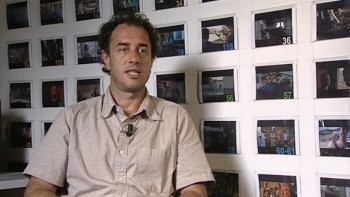 Gomorrah: Five Stories (1:02:29, Letterbox 4x3):
Gomorrah: Five Stories (1:02:29, Letterbox 4x3):
Filmed in 2008 for Fandango and practically narration-free, this isn't so much of a sectional behind-the-scenes feature. It's more of a collection of raw off-set footage, scenes from the film, and archive footage. Some of the footage can be rather interesting, including a candid flare-up by one of the actors late in the piece. Though cumbersome at times due to the lack of real direction, the footage is interesting enough to merit the drudge.
Interview with Matteo Garrone (22:36, 16x9):
Shot specifically for The Criterion Collection in 2009, director Garrone discusses the danger behind adapting the book that caused the author so many issues -- including a requirement for 24/7 police escort. He talks about how accomidating the local people were to the shoot, using claustrophobia in the film, attaching Sancho Panza and Don Quixote to the film's aspiring Scarface loons, and infusing surprises within the flow. It's a highly elaborative and intense interview.
Interview with Tony Servillo (13:54, 16x9):
Also shot in 2009 specifically for the collection, this interview with actor Servillo discusses his connection with Garrone's family, his impressions on the book's literal yet personal prose, and his experience shooting the quarry dumping sequence. He talks a great deal about Garrone's method and joy in assembling Gomorrah, as well as discussion about the film's reception.
Actors (10:32, Letterbox 4x3):
Gianfelice Imparato and Tom Servillo enter into the picture, following Servillo's quick narration of some of the novel. They mostly discuss character motivations and other actors, pretty much in standard marketing interview fashion -- only in a more intimate setting.
Interview with Author Roberto Saviano (42:58, Letterbox 4x3):
We're taken through a very lengthy sit-down with author Saviano, where he talks about his experience in both the conception and release of the novel. He also discusses real-life experiences, motivations behind his characters, his fondness of Pasquale's storyline, and the density of all the life-to-novel adaptations. He's non-stop for the entire span of time, taking us through his fascinating journey in his content.
Also included are a set of Deleted Scenes (12:56, 16x9), presented in the same quality and clarity as the transfer for the film itself, as well as a Trailer (2:28, 16x9) on Disc One.
Final Thoughts:
Powerful and haunting, Gomorrah goes against the conventions of the glamorized gangster films by giving us a portrait of the "truth" underneath the Italian crime syndicate. It crafts five stories that dive deep into the cutthroat network of both fledgling and veteran gangsters, harking to flashes of violence and gut-churning drama for its punch. The fact that it's a sketching of real-life events makes it all the more potent, along with the realistic, almost documentary-style visuals. Criterion have once again risen to the occasion with a strong cinematic projection of this gritty film, as well as including a dense amount of both new and imported features that encapsulates into a Highly Recommended package. IFC and The Criterion Collection's foray into a corroboration is, so far, a strong success.
Thomas Spurlin, Staff Reviewer -- DVDTalk Reviews | Personal Blog/Site
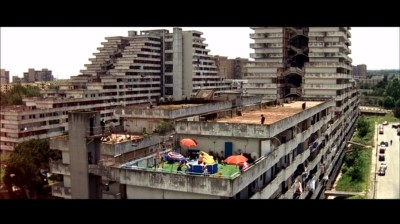 |
Gomorrah (Gomorra) begins with a mob hit, done in Italian director Matteo Garrone's methodical style. Slowly and steadily, he reveals a gangster tanning in a brightly-lit booth, conversing with colleagues in mundane, masculine fashion. The camera gracefully flows throughout the spa they're visiting, tempering us to their conversational pace by luring our attention towards their characters. Then, after this deliberately lengthy exposition, the bullet-flying hit occurs -- very simply, almost like snapping their necks with the rapidity. That's where Garrone's expositional film about the Italian mob finds its axis, by painting a gritty, real portrait of organized crime that's fascinating within its calculated measures.
It bases its content on Robert Saviano's partly non-fiction novel of the same name, an exposé on the Camorra organized crime syndicate and its Neapolitan underground dealings. Five interlinked stories tackle different corrupt elements: training and recruiting young upstarts to the gang, sketchy waste disposal, monetary distribution to imprisoned gang members' families, the Camorra's foot-in-the-door with popular culture textiles via a couture designer (Salvatore Cantalupo), and the ways that the lifestyle's greed can appeal to and contort teenage minds. Director Garrone zeroes in on an observational manner with soaking in the dialogue and witnessing the myriad of character reactions, concentrating on the damaging human effects that the cutthroat, heartless network of activity has on individuals.
Within its length and grace of motion, Gomorrah becomes a highly demanding crime drama. Dialogue mixes half and half with deliberate close-ups and wavering camera movement, creating a sense of both disorientation and awe within the viewer witnessing the realistic, gritty modern-era portrayal of the Camorra's many layers. Leanness isn't exactly a claim to its visceral success, however there's something beguiling about its earnest capturing of Naples' troubling underbelly. Energy doesn't come barreling around every single corner, though a slow, gut-churning burn can be felt from start to finish as we watch illegal waste dumps. Instead, strategic bursts of force are experienced throughout the film, and every last one of them becomes memorable because of their precise placement.
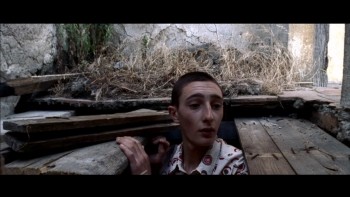 | 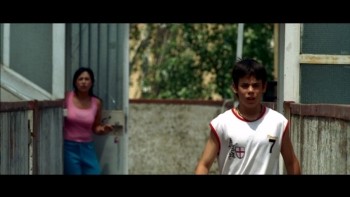 |
Marco Onorato's superb achievement behind the camera in Gomorrah should be highly regarded as one of the very finest of its year. This could've been a picture that incorporated the now-popular, ultra-stylized form of cinematography, boasting loud colors and intense contrast in a whirlwind of quick cuts and such. That, however, isn't the aim for Director Garrone and his cinematographer; they instead photograph the Naples activity with long cuts and faithful, naturally-flowing cinematography. As we follow behind Toto while he delivers groceries and proves himself to the elder gangsters as a valuable asset, these lengthy shots give a sense of stark realism behind his story -- reminding me in patches of Gus Van Sant's Elephant in visual tone. It carries over to the hell-bent, Scarface-imitating youngsters Marco and Ciro, to the training of young college graduate Roberto under illegal waste dumper Franco (Tony Servillo), and then to the fear-riddled scurrying of Don Ciro (Gianfelice Imparato) as he delivers payments to families in the violence riddled housing development. It connects them all as entities consumed by the same disorienting force.
Giving gravitas to the fluid capturing of the network, the performances from the ensemble cast in Gomorrah are universally superb. Considering that we've got no less than ten focal characters in all the bustle, that's quite a feat. Young actor Salvatore Abruzzese, who gives a powerful turn as young Toto, and the pairing of Marco Macor and Ciro Petrone as the ambitious Tony Montana copycats craft a believable tone to the wealth and power hungry youths. Their showings are the core to Gomorrah's emotional resonance, giving breath and reality to the cascade of corruption trickling down. It links with the recent-grad toxic waste management protégé -- disquietingly performed by Carmine Paternoster -- in a way that shows even more stable-minded individuals can be cornered into the vacuum-like suction of its destructive nature.
Amid death and a focus on guns, cash, and power, Gomorrah's tone takes a more thought-provoking road by staying irrefutably bleak. Its relentless desolation and expansive tracking shots can, at times, wear on both the patience and the nerves, even while it's properly emitting the essence of flash-in-a-pan lives under organized crime's painful scrutiny. Yet, this bold realness doesn't simply turn its back on the glamorized mobster notions established in Scarface, Goodfellas, or others of their ilk, but uses our awareness of them as the "glitzy" inspiration for its documentarian anti-mobster message. And as each of the five stories come to a close, it ends with a tragic poise that hammers home the pains of each -- and the glimmer of headstrong hope within one. Quite simply, I was left in awe after Garrone's film came to its conclusion, leaving raw wounds that only intensify when you reflect on the fact that these stories are hinged on truth.
The DVD:
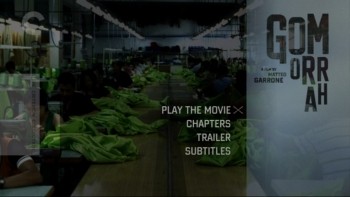 | 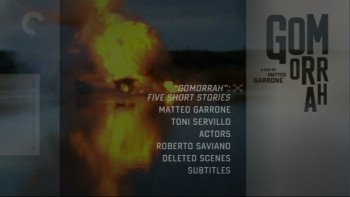 |
In the first wave of their extended collaboration with IFC films, Criterion have released Gomorrah in a double-disc DVD that offers a highly pleasing presentation. Its whimsical cover artwork mimics a color version of one of the film's posters, while the inner artwork showcases a shot of the housing project -- a shot that, I believe, comes directly after a harrowing moment within the picture. Inside, a Booklet has been made available that contains a chapter list, cast/crew credits, and an essay by Chuck Stephens entitled "Terminal Beach".
Video and Audio:
Taken from a digital intermediate and presented in a 2.35:1 anamorphic image that both Matteo Garrone and cinematographer Marco Onorato have approved, Criterion's transfer for Gomorrah preserves the grainy, gritty attitude that adorns the film's tone throughout. Specific details, like wood grain and hay in backdrops and the grimy debris dropped on flooring, exhibit well-pitched detail through a precise, appropriate level of grain. It retains a cinematic look from start to finish, though it's a bit hazy -- artistic intent in part, but also a little more blurred than I'd like. However, the level of color correctness and contrast aptitude is astounding, providing a true and stable palette that matches the demeanor of the picture splendidly.
An Italian Dolby Digital 5.1 track has been made available with the visual treatment that's been mastered at 24-bit from the digital source, and it's a subtly striking presentation. Case in point, the scene featuring our rambunctious duo of gangster-wannabes firing off gunshots towards a patch of water sounded splendid, replicating the gunfire with punchy mid-range levels and an appropriate echo reaching to the rear channels. Several other gunshots crop up throughout the picture, none of them ceasing to make me jump from my seat with their placement and natural punch. Volume mixing is handled with incredible strength, with the dialogue and secondary sounds -- ruffling of a plastic bag, music playing in a car -- maintaining proper buoyancy. Subtitles are, as per Criterion's repertoire, available in optional English subtitles, which are exceptional.
Special Features:
 Gomorrah: Five Stories (1:02:29, Letterbox 4x3):
Gomorrah: Five Stories (1:02:29, Letterbox 4x3): Filmed in 2008 for Fandango and practically narration-free, this isn't so much of a sectional behind-the-scenes feature. It's more of a collection of raw off-set footage, scenes from the film, and archive footage. Some of the footage can be rather interesting, including a candid flare-up by one of the actors late in the piece. Though cumbersome at times due to the lack of real direction, the footage is interesting enough to merit the drudge.
Interview with Matteo Garrone (22:36, 16x9):
Shot specifically for The Criterion Collection in 2009, director Garrone discusses the danger behind adapting the book that caused the author so many issues -- including a requirement for 24/7 police escort. He talks about how accomidating the local people were to the shoot, using claustrophobia in the film, attaching Sancho Panza and Don Quixote to the film's aspiring Scarface loons, and infusing surprises within the flow. It's a highly elaborative and intense interview.
Interview with Tony Servillo (13:54, 16x9):
Also shot in 2009 specifically for the collection, this interview with actor Servillo discusses his connection with Garrone's family, his impressions on the book's literal yet personal prose, and his experience shooting the quarry dumping sequence. He talks a great deal about Garrone's method and joy in assembling Gomorrah, as well as discussion about the film's reception.
Actors (10:32, Letterbox 4x3):
Gianfelice Imparato and Tom Servillo enter into the picture, following Servillo's quick narration of some of the novel. They mostly discuss character motivations and other actors, pretty much in standard marketing interview fashion -- only in a more intimate setting.
Interview with Author Roberto Saviano (42:58, Letterbox 4x3):
We're taken through a very lengthy sit-down with author Saviano, where he talks about his experience in both the conception and release of the novel. He also discusses real-life experiences, motivations behind his characters, his fondness of Pasquale's storyline, and the density of all the life-to-novel adaptations. He's non-stop for the entire span of time, taking us through his fascinating journey in his content.
Also included are a set of Deleted Scenes (12:56, 16x9), presented in the same quality and clarity as the transfer for the film itself, as well as a Trailer (2:28, 16x9) on Disc One.
Final Thoughts:
Powerful and haunting, Gomorrah goes against the conventions of the glamorized gangster films by giving us a portrait of the "truth" underneath the Italian crime syndicate. It crafts five stories that dive deep into the cutthroat network of both fledgling and veteran gangsters, harking to flashes of violence and gut-churning drama for its punch. The fact that it's a sketching of real-life events makes it all the more potent, along with the realistic, almost documentary-style visuals. Criterion have once again risen to the occasion with a strong cinematic projection of this gritty film, as well as including a dense amount of both new and imported features that encapsulates into a Highly Recommended package. IFC and The Criterion Collection's foray into a corroboration is, so far, a strong success.
|
| Popular Reviews |
| Sponsored Links |
|
|
| Sponsored Links |
|
|
| Release List | Reviews | Shop | Newsletter | Forum | DVD Giveaways | Blu-Ray | Advertise |
|
Copyright 2024 DVDTalk.com All Rights Reserved. Legal Info, Privacy Policy, Terms of Use,
Manage Preferences,
Your Privacy Choices | |||||||













